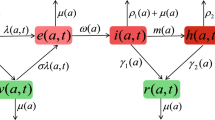Abstract
The question about whether a periodic solution can exists for a given epidemiological model is a complicated one and has a long history (Hethcote and Levin, Applied math. ecology, biomathematics, vol 18. Springer, Berlin, pp 193–211, 1989). For influenza models, it is well known that a periodic solution can exists for a single-strain model with periodic contact rate (Aron and Schwartz, J Math Biol 110:665–679, 1984; Kuznetsov and Piccardi, J Math Biol 32:109–121, 1994), or a multiple-strain model with cross-immunity and quarantine class or age-structure (Nuño et al., Mathematical epidemiology. Lecture notes in mathematics, vol 1945. Springer, Berlin, 2008, chapter 13). In this paper, we prove the local asymptotic stability of the interior steady-state of a two-strain influenza model with sufficiently close cross-immunity and no quarantine class or age-structure. We also show that if the cross-immunity between two strains are far apart; then it is possible for the interior steady-state to lose its stability and bifurcation of periodic solutions can occur. Our results extend those obtained by Nuño et.al. (SIAM J Appl Math 65:964–982, 2005). This problem is important because understanding the reasons behind periodic outbreaks of seasonal flu is an important issue in public health.





Similar content being viewed by others
References
Alfaro-Murillo JA, Towers S, Feng Z (2013) A deterministic model for influenza infection with multiple strains and antigenic drift. J Biol Dyn 7:199–211
Andreasen V, Lin J, Levin SA (1997) The dynamics of cocirculating influenza strains conferring partial cross-immunity. J Math Biol 35:825–842
Aron JL, Schwartz IB (1984) Seasonality and period-doubling bifurcations in an epidemic model. J Math Biol 110:665–679
Castillo-Chavez C, Hethecote HW, Andreasen V, Levin SA, Liu WM (1989) Epidemiological models with age structure, proportionate mixing, and cross-immunity. J Math Biol 27:233–258
Center for Disease Control and Prevention (2014) Types of influenza Viruses. http://www.cdc.gov/flu/about/viruses/types.htm. Accessed 21 Feb 2016
Chung KW, Liu Z (2011) Nonlinear analysis of chatter vibration in a cylindrical transverse grinding process with two time delays using a nonlinear time transformation process. Nonlinear Dyn 66:441–456
Coburn BJ, Wagner GB, Blower S (2009) Modeling influenza epidemics and pandemics: insights into the future of swine flu (H1N1). BMC Med 7:30
Edelstein-Keshet L (2005) Mathematical models in biology. SIAM, Philadelphia
Gog JR, Grenfell BT (2002) Dynamics and selection of many-strain pathogens. PNAS 99:17209–17214
Gog JR, Swinton J (2002) A status-based approach to multiple-strain dynamics. J Math Biol 44:169–184
Hethcote HW, Levin SA (1989) Periodicity in epidemiological models. In: Applied math. ecology, biomathematics, vol 18. Springer, Berlin, pp 193–211
Kuznetsov YA, Piccardi C (1994) Bifurcation analysis of periodic SEIR and SIR epidemic models. J Math Biol 32:109–121
Lin J, Andreasen V, Levin SA (1999) Dynamics of influenza A drift: the linear three-strain model. Math Biosci 162:33–51
Nuño M, Feng Z, Martcheva M, Castillo-Chavez C (2005) Dynamics of two-strain influenza with isolation and partial cross-immunity. SIAM J Appl Math 65:964–982
Nuño M, Castillo-Chavez C, Feng Z, Martcheva M (2008) Mathematical models of influenza: the role of cross-immunity, quarantine and age-structure. In: Mathematical epidemiology. Lecture notes in mathematics, vol 1945. Springer, Berlin
Schwartz IB, Smith HL (1983) Infinite subharmonic bifurcation in an SEIR epidemic model. J Math Biol 18:233–253
Author information
Authors and Affiliations
Corresponding author
Appendices
Appendix 1: Proof of (5.4)
We show how to simplify E and G. Let \(G_i := \sigma _{ij}\sigma _{ji}(\sigma _{ji}x_{i1}+1) + \mathcal {R}_i^0S\sigma _{ij}(1-\sigma _{ji})\,[x_{i1}(1+\sigma _{ji})+x_{j1}(1+\sigma _{ij})+2].\) Then \(G = x_{11}x_{21}\gamma _1^2\gamma _2^2(G_1+G_2)\). Using (3.7), (3.8), and \(S(1+x_{11}+x_{21}) = 1\), we have, after some algebra,
Similarly, \(E = -\gamma _1\gamma _2(x_{11}\gamma _1E_1+x_{21}\gamma _2E_2)\), where
One can then prove (1) by using mathematical software to show that \(\mathcal {H}\), defined by (5.2) with E and G given above, is same as the right side of (5.4) with \(q_{ij}\) defined by (5.3).
Appendix 2: Proof of (5.5)
Let \(e_i = \mathcal {R}_i^0J_j\). Then \(Q = q_{11}q_{22} - q_{12}^2/4 >0\) is equivalent to
Recall from Lemma 5.4 \(D_i = \mathcal {R}_i^0(x_{j1}^0\sigma )(1-\mathcal {R}_j^0S^0)\). Then \(e_i = \mathcal {R}_i^0 - D_iS^0(1-\sigma )\). Using mathematical software, one can show that
where
Note that \(T_1, T_{2i}\) and \(T_{23}\) have the common factor \(\sigma (S^0)^2(1-\sigma )^2\). Let \(T_1^{\,\prime }, T_{2i}^{\,\prime }\) and \(T_{23}^{\,\prime }\) be \(T_1, T_{2i}\) and \(T_{23}\) without this common factor, respectively. Then the first term in (5.5) is \(T_1^{\,\prime }\) and the last two terms equal \(T_{23}^{\,\prime }\). If we use mathematical software to calculate the difference between \(T_{21}^{\,\prime }D_1 + T_{22}^{\,\prime }D_2\) and the second term of (5.5), we obtain \(2S^0(1-\sigma )(\mathcal {R}_1^0-\mathcal {R}_2^0)(D_1\mathcal {R}_2^0- D_2\mathcal {R}_1^0)\). This expression equals zero because in the discussion after (5.6), we note that \(x_{21}^0\sigma (1-\mathcal {R}_2^0S^0) = x_{11}^0\sigma (1-\mathcal {R}_1^0S^0)\), which implies that \(D_1\mathcal {R}_2^0 = D_2\mathcal {R}_1^0\). The proof of Lemma 5.4 is complete.
Rights and permissions
About this article
Cite this article
Chung, K.W., Lui, R. Dynamics of two-strain influenza model with cross-immunity and no quarantine class. J. Math. Biol. 73, 1467–1489 (2016). https://doi.org/10.1007/s00285-016-1000-x
Received:
Revised:
Published:
Issue Date:
DOI: https://doi.org/10.1007/s00285-016-1000-x




